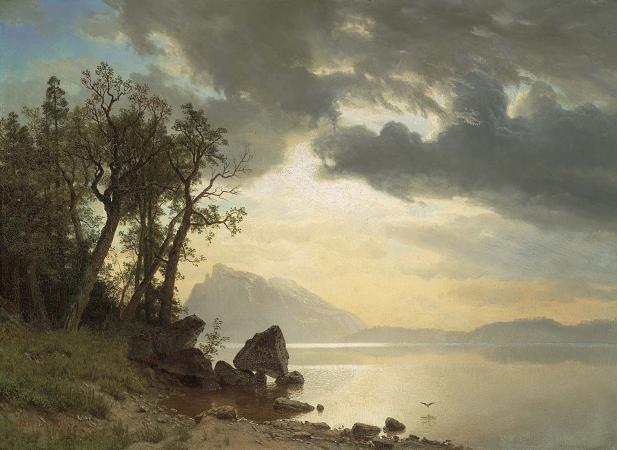Albert Bierstadt (1830 - 1902). Albert Bierstadt was a German-American painter best known for his lavish, sweeping landscapes of the American West. He joined several journeys of the Westward Expansion to paint the scenes. He was not the first artist to record the sites, but he was the foremost painter of them for the remainder of the 19th century. Bierstadt was born in Prussia, but his family moved to the United States when he was 1. He returned to study painting for several years in Düsseldorf. He became part of the Hudson River School in New York, an informal group of like-minded painters who started painting along the Hudson River. Their style was based on carefully detailed paintings with romantic, almost glowing lighting, sometimes called luminism. Bierstadt was an important interpreter of the western landscape, and he is also grouped with the Rocky Mountain School. Bierstadt was born in Solingen, Germany, the son of Christina M. and Henry Bierstadt, a cooper. His brother was prominent photographer Edward Bierstadt. Albert was just a year old when his family immigrated to New Bedford, Massachusetts in 1831. He made clever crayon sketches in his youth and developed a taste for art. In 1851, Bierstadt began to paint in oils. He returned to Germany in 1853 and studied painting for several years in Düsseldorf with members of its informal school of painting. After returning to New Bedford in 1857, he taught drawing and painting briefly before devoting himself full-time to painting. In 1858, Bierstadt exhibited a large painting of a Swiss landscape at the National Academy of Design, which gained him positive critical reception and honorary membership in the Academy. Bierstadt began painting scenes in New England and upstate New York, including in the Hudson River valley. He was part of a group of artists known as the Hudson River School. In 1859, Bierstadt traveled westward in the company of Frederick W. Lander, a land surveyor for the U.S. government, to see those western American landscapes for his work. He returned to a studio he had taken at the Tenth Street Studio Building in New York with sketches for numerous paintings he then finished. In 1860, he was elected a member of the National Academy of Design; he received medals in Austria, Bavaria, Belgium, and Germany. In 1863, he traveled West again, this time in the company of the author Fitz Hugh Ludlow, whose wife he later married. Throughout the 1860s, Bierstadt used studies from this trip as the source for large-scale paintings for exhibition and he continued to visit the American West throughout his career. The immense canvases he produced after his trips with Lander and Ludlow established him as the preeminent painter of the western American landscape. Bierstadt's technical proficiency, earned through his study of European landscape, was crucial to his success as a painter of the American West and accounted for his popularity in disseminating views of the Rocky Mountains to those who had not seen them. During the American Civil War, Bierstadt was drafted in 1863 and paid for a substitute to serve in his place. By 1862, he had completed one Civil War painting Guerrilla Warfare, Civil War based on his brief experiences with soldiers stationed at Camp Cameron in 1861. That painting was based on a stereoscopic photograph taken by his brother Edward Bierstadt, who operated a photography studio at Langley's Tavern in Virginia. The painting received a positive review when it was exhibited at the Brooklyn Art Association at the Brooklyn Academy of Music in December 1861. Curator Eleanor Jones Harvey observed that the painting, created from photographs, is quintessentially that of a voyeur, privy to the stories and unblemished by the violence and brutality of first-hand combat experience. Financial recognition confirmed his status: The Rocky Mountains, Lander's Peak, completed in 1863, was purchased for $25,000 in 1865. In 1867, Bierstadt traveled to London, where he exhibited two landscape paintings in a private reception with Queen Victoria. He traveled through Europe for two years, cultivating social and business contacts to sustain the market for his work overseas. His exhibition pieces were brilliant images, which glorified the American West as a land of promise and fueled European emigration. He painted Among the Sierra Nevada, California in his Rome studio for example, showed it in Berlin and London before shipping it to the U.S. As a result of the publicity generated by his Yosemite Valley paintings in 1868, Bierstadt's presence was requested by every explorer considering a westward expedition, and he was commissioned by the Atchison, Topeka, and Santa Fe Railroad to visit the Grand Canyon for further subject matter. Bierstadt's choice of grandiose subjects was matched by his entrepreneurial flair.
more...














